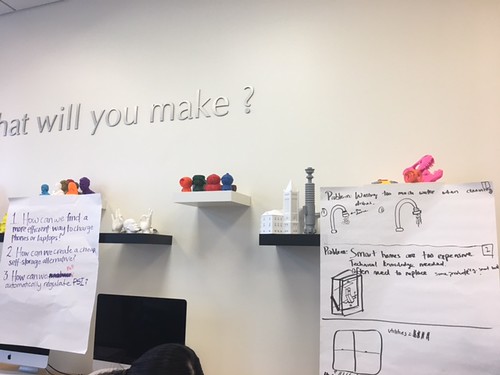This week we were back in the Maker Lab after two weeks away. At the beginning of class we broke off into our groups and were able to start discussing our projects. As we learned from our session with Design for America, the best designs do not start immediately from a solution. Instead, we took an approach that had us start from a broad problem before narrowing it down to a single specific problem that a unique solution could be developed to solve that problem.’
The Interaction Design Foundation says, “the first step of product thinking is to determine the problem that your users are looking to solve.” If a problem exists, consumers will have a reason to purchase a solution. Therefore, successful designs should begin with the problem and affected users. We also considered the “10 ways to evaluate a new business idea” article when generating ideas to work with. Our group thought about problems we encountered in our lives and identified these three problems: overcharging laptops and cell phones, reliability of self-storage options in public spaces, and keeping athletic equipment up to specifications over time. While these were good to use for this exercise, Charlene, Carter, and I agreed that for the purpose and scale of the semester project, these problems are not realistic to find a solution for.
A valuable part of our class session was peer review. One member of each group rotated to another group in order to offer constructive feedback on the problems each group identified as they worked towards a solution. Going forward, we now know how valuable it can be to receive an outside opinion on a project or idea. An outsider can find flaws or even alternatives that were previously overlooked. UK based Corintech defines design peer review as “a process whereby a design project (or aspect of) is reviewed and evaluated by a person, or team, not directly involved with the project, but appropriately qualified to provide input that will either reinforce a design solution, or provide a route to an improved alternative.” It continues on to say that utilizing the experience and expertise other people will add valuable insight. As we develop our project, we will be sure to reach out to classmates or others who are familiar with the topics we are working with for their feedback.
In the second half of class, Mike Bohlmann, Assistant Dean of Technology in the College of Media and self-proclaimed Maker came to discuss many of the projects he has worked on. It is important to note that all of the examples he showed us started from a problem that he then worked to solve by making something. He did not begin his process by making a product and finding a problem to associate it with. From digitalizing a Star Wars game to making a holder for his airplane radio, he identified problems in his life then developed a solution. Another takeaway from the presentation was that Making can be a fun, affordable hobby that can be pursued at anytime. On top of professional and family obligations, Mike still has time to make prototypes, often supporting his other hobbies and passions. Even after this class ends and I am working full-time, I hope that Making can be an outlet for learning and having fun.



